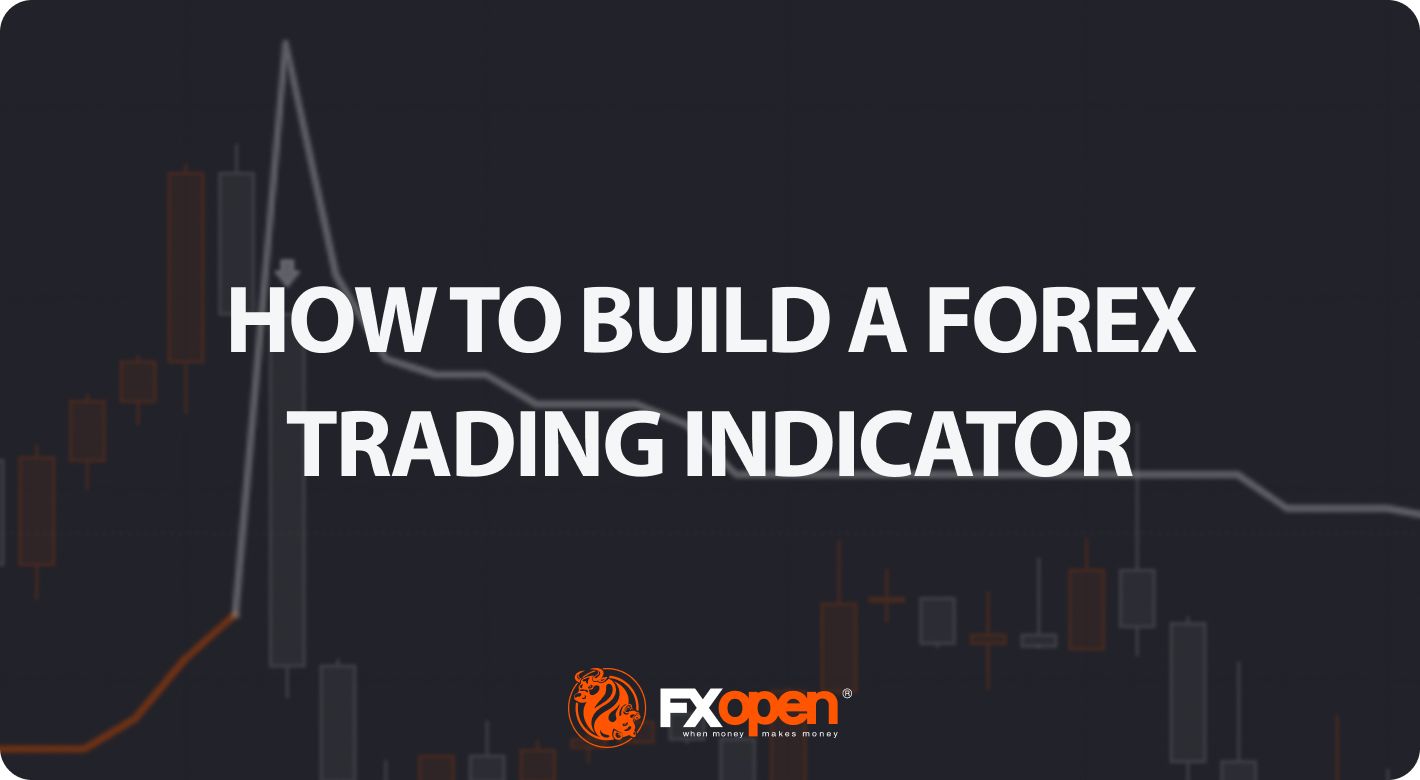FXOpen

In the dynamic world of financial trading, understanding how to build a trading indicator is a valuable skill. This article is designed to navigate you through the essential steps of creating your own trading indicators, offering a blend of technical and practical insights to potentially enhance your market analysis and trading decisions.
Understanding Trading Indicators
Trading indicators are essential tools in analysing financial markets, offering traders valuable insights into market trends and potential trading opportunities. These mathematical calculations are applied to various market data points like price, volume, and sometimes open interest. In forex trading, indicators play a crucial role in analysing currency pair movements.
There are several types of indicators, each serving a specific purpose:
- Trend indicators help identify the direction of market movements.
- Momentum indicators gauge the speed of these movements.
- Volume indicators look at trading volumes to understand market strength.
- Volatility indicators provide insight into the stability or instability of currency prices.
While there are hundreds of indicators to choose from, some traders choose to develop their own based on their unique market observations.
Basic Components of a Trading Indicator
The core components of a trading indicator are price, volume, and time. These elements are fundamental in analysing market data and building various tools.
- Price: The most critical component, price, is used in almost every trading indicator. It includes open, high, low, and close prices of trading instruments. Price data is essential for constructing trend-following tools like moving averages and oscillators like the Stochastic RSI.
- Volume: Volume indicates the number of contracts traded in a given period. It provides insights into the strength or weakness of a market move. Volume-based tools, like the Volume Oscillator or On-Balance Volume (OBV), help traders understand the intensity behind price movements.
- Time: Indicators use time periods to analyse market trends. This could be short-term (minutes, hours), medium-term (days, weeks), or long-term (months, years). Time frames influence the sensitivity of an indicator, with shorter periods typically offering more signals.
Choosing the Right Data and Tools
Selecting appropriate data and tools is a critical step in building effective trading indicators. For data, accuracy and relevance are paramount. Traders typically use historical price data alongside volume data.
For tools, traders consider user-friendly platforms that offer robust functionality for creating and testing tools. Platforms like TradingView and MetaTrader offer extensive libraries and community support, facilitating the development of customised indicators.
Additionally, programming languages like Python, C# and R, known for their data analysis capabilities, can be powerful tools for creating more complex indicators. FXOpen’s TickTrader, for instance, supports custom C#-based indicators and offers powerful backtesting tools.
How to Build a Trading Indicator: A Step-by-Step Walkthrough
Developing an indicator involves several key steps, each crucial to ensure the final tool is effective and aligns with your trading strategy.
1. Define the Objective
Begin by clearly defining what you want your tool to achieve. Is it to identify trends, pinpoint entry and exit points, or gauge market volatility? Your objective will guide the type of indicator you develop, such as trend-following, momentum, or volatility-based.
2. Select the Formula
Choose or develop a mathematical formula that your tool will use. This could be a simple moving average, a complex algorithm involving multiple data points, or something entirely unique. The formula should reflect the market phenomena you aim to capture.
3. Coding the Indicator
Translate your formula into code. If using platforms like TradingView, MetaTrader or TickTrader, their scripting languages (Pine Script for TradingView, MQL4/5 for MetaTrader, C# for TickTrader) are designed for this purpose. Ensure the code is clean, well-documented, and easily adjustable.
4. Incorporate Visualisation
Decide how the indicator will visually appear on the chart or in a separate window. This could be in the form of lines, bars, dots, or other graphical representations. The visual aspect should make it easy to interpret signals at a glance.
5. Backtesting
Before applying your indicator in live trading, it’s crucial to backtest it using historical data. This topic is expanded on below.
Testing and Refining Your Indicator
Testing and refining your trading indicator is a critical phase in its development, ensuring its potential effectiveness and reliability in real market conditions.
- Backtesting: This is the process of testing your indicator against historical data. Backtesting helps evaluate how it would’ve performed in different market scenarios, revealing its strengths and weaknesses. It's essential to test over various time frames and market conditions to ensure robustness.
- Analysing Results: Assess the indicator's accuracy, consistency, and responsiveness to market changes. Look for patterns in its performance, such as frequent false signals or lag in response to price movements.
- Refinement: Based on the backtesting results, refine your indicator. This could involve tweaking the formula, adjusting parameters like time periods or thresholds, or enhancing the visualisation for clearer signals.
- Forward Testing: After adjustments, conduct forward testing in a simulated or live trading environment with real-time data. This helps verify its performance in current market conditions.
Remember, no indicator is perfect; the goal is to develop a tool that consistently aids in your trading outcomes.
The Bottom Line
The journey of building an indicator is both challenging and rewarding. From selecting the right data and tools to carefully coding and testing your creation, each step plays a vital role in crafting an effective aid for trading decisions. For those looking to integrate their custom indicators into a professional trading environment, opening an FXOpen account offers the opportunity to leverage your unique tools in the dynamic TickTrader platform.
This article represents the opinion of the Companies operating under the FXOpen brand only. It is not to be construed as an offer, solicitation, or recommendation with respect to products and services provided by the Companies operating under the FXOpen brand, nor is it to be considered financial advice.
Stay ahead of the market!
Subscribe now to our mailing list and receive the latest market news and insights delivered directly to your inbox.








